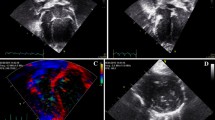Summary
The purpose of this investigation was to validate in vivo the accuracy of videoangiocardiographic right ventricular volume determination. Thus the stroke volume of the right ventricle as difference of enddiastolic and endsystolic volume was determined simultaneously (n=70) by videoangiocardiography and with an electromagnetic flowmeter in 7 open-chested pigs with an average weight of 18.5 kg. Model volumes, calculated with the multiple slices and the area-length methods on the basis of mono- and biplane angiographic right ventricular projections, were corrected conventionally and with factors appropriate for cardiac phase and spatial orientation. The correlation between electromagnetic and angiographic stroke volume was the lowest (r=0.802) when monoplane and highest (r=0.949) when biplane methods were used. A systematic error could be prevented (y=−0.3+1.0x; Syx=±1.96 ml) by applying correction factors appropriate for cardiac phase and spatial orientation. The statistical error was independent of the correction used. The correlation coefficient for the optimal corrected monoplane method based on the lateral projection was r=0.861 and for the ap plane r=0.930.
Right ventricular stroke volume can be determined videoangiocardiographically without systemic error and with an acceptable statistical error, if spatial orientation and cardiac phase are considered. If only monoplane equipment is available, the ap projection is preferable.
Zusammenfassung
Das Ziel dieser Untersuchung war es, die Genauigkeit der video-angiokardiographischen Volumenbestimmung des rechten Ventrikels in vivo zu bestimmen. Dazu wurde bei 7 Schweinen mit geöffnetem Thorax (Durchschnittsgewicht 18,5 kg) das Schlagvolumen des rechten Ventrikels (n=70) gleichzeitig video-angiokardiographisch als Differenz zwischen enddiastolischem und endsystolischem Volumen und mit einer elektromagnetischen Blutflußmeßsonde ermittelt. Die enddiastolischen und endsystolischen Modell-Volumina wurden auf der Basis mono- und biplaner Projektionen mit der Scheibchen- und der Flächen-Längen-Methode berechnet. Sie wurden sowohl konventionell als auch mit Faktoren korrigiert, die die räumliche Orientierung des rechten Ventrikels in bezug auf die Röntgenebenen als auch auf die Herzphase berücksichtigen. Die Korrelation zwischen elektromagnetischen und video-angiokardiographischen Schlagvolumina war am niedrigsten (r=0,802) bei Nutzung monoplaner und am höchsten (r=0,949) bei Nutzung biplaner Methoden.
Ein systematischer Fehler wurde vermieden (y=−0,3+1,0 x; Syx=±1,96 ml), wenn Korrekturfaktoren angewandt wurden, die die räumliche Orientierung und Herzphase berücksichtigen. Der Korrelationskoeffizient für die optimal korrigierte monoplane Methode betrug r=0,861 für die laterale und r=0,930 für die anteriorposteriore Projektion des rechten Ventrikels. Das rechtsventrikuläre Schlagvolumen kann ohne systematischen und mit einem akzeptablen statistischen Fehler in vivo bestimmt werden, wenn räumliche Orientierung und Herzphase des rechten Ventrikels berücksichtigt werden. Bei Anwendung monoplaner Einrichtungen ist die a.-p. Projektion der lateralen vorzuziehen.
Similar content being viewed by others
References
Bentivoglio, L. G., L. D. Griffith, A. J. Cuesta, M. Geczy: Radiographic evaluation of formulas for left ventricular volume using canine casts. J. Appl. Physiol.33, 365–374 (1972).
Chaitman, R. B., H. Demots, D. J. Bristow, J. Roesch, S. H. Rashimtoola: Objective and subjective analysis of left ventricular angiograms. Circulation52, 420–425 (1975).
Chapman, C. B., O. Baker, J. Reynolds, J. F. Bonte: Use of biplane cinefluorography for measurement of ventricular volume. Circulation18, 1105–1117 (1958).
Dodge, H. T., H. Sandler, D. W. Ballew, J. D. Lord: The use of biplane angiocardiography for the measurement of left ventricular volume in man. Amer. Heart J.60, 762–776 (1960).
Graham, T. P., J. M. Jarmakani, G. F. Atwood, R. V. Canent, Jr.: Right ventricular volume determinations in children. Normal values and observations with volume or pressure overload. Circulation47, 144–153 (1973).
Graham, T. P., J. M. Jarmakani, R. V. Canent, Jr., M. P. Capp, M. S. Spach: Characterisation of left heart volumes and mass in normal children and in infants with intrinsic myocardial disease. Circulation38, 826–837 (1968).
Heintzen, P. H., V. Malerczyk, J. Pilarczyk, K. W. Scheel: On-line processing of the video-image for left ventricular volume determination. Comput. Biomed. Res.4, 474–485 (1971).
Lange, P. E., D. G. W. Onnasch, F. Farr, V. Malerczyk, P. H. Heintzen: Analysis of left and right ventricular size and shape, as determined from human casts. Description of the method and its validation. Europ. J. Cardiol.8, 431–448 (1978).
Lange, P. E., D. G. W. Onnasch, F. Farr, P. H. Heintzen: Angiocardiographic right ventricular volume determination. Accuracy, as determined from human casts, and clinical application. Europ. J. Cardiol.8, 477–501 (1978).
Mennicken, U.: Die Bestimmung der Herzkammervolumina und des Schlagvolumens des linken Ventrikels mit der videometrischen Dimensionsmessung, der videodensitometrischen Auswaschtechnik und der Pressure-Pulse-Methode im Tierexperiment. Habilitationsschrift (University of Cologne 1974).
Onnasch, D. G. W., V. Malerczyk, J. Pilarczk, P. E. Lange, P. H. Heintzen: A system for acquisition, documentation, and analysis of manually outlined ventricular angiograms. In: Roentgen-Video-Techniques, ed. by P. H. Heintzen and J. H. Bürsch. 139–145. Thieme Verlag (Stuttgart 1978).
Author information
Authors and Affiliations
Additional information
This study was supported in part by grants HE 769-1 from the Deutsche Forschungsgemeinschaft and 202a from Bundesministerium für Forschung und Technologie, 5300 Bonn, FRG.
Rights and permissions
About this article
Cite this article
Lange, P.E., Beurich, H.W., Onnasch, D.G.W. et al. The accuracy of experimentally determined angiographic right ventricular volume. Basic Res Cardiol 78, 172–182 (1983). https://doi.org/10.1007/BF01906670
Received:
Issue Date:
DOI: https://doi.org/10.1007/BF01906670




